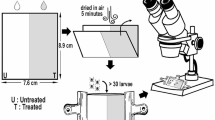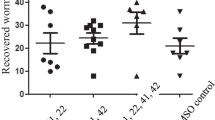Abstract
The rapid development of anthelminthic resistance has limited the success of traditional control programmes in several countries, thereby forcing the researchers to search for alternatives. In vitro anthelmintic activities of crude aqueous and hydro-alcoholic extracts of the leaves of Eucalyptus globulus were investigated against the egg and larvae of naturally infected sheep. In the phytochemical analyses, tannins and flavonoids were the main metabolites identified in the extract. The aqueous extract of E. globulus was also investigated for in vivo anthelmintic activity in naturally infected sheep. The various blood parameters, coupled with effects on marker enzymes and antioxidant status, were evaluated during the trial period. Methanolic extract showed better ED50 (3.756 mg/ml) and ED99 (33.809 mg/ml) values in comparison with aqueous extract (ED50 = 1.502 and ED99 = 7.10 mg/ml) in the egg hatch assay. Inverse was true in larval development and larval paralysis tests. The aqueous extract’s ED50 = 19.994 and ED99 = 108.931 mg/ml values in the larval development test and ED50 = 19.994 and ED99 = 108.931 mg/ml in the larval paralysis test were more potent than those of its methanolic counterpart with ED50 = 15.595 and ED99 = 94.493 mg/ml and ED50 = 15.595and ED99 = 94.493 mg/ml, respectively. A significant amount of 66 % faecal egg count reduction was observed in in vivo trail using the aqueous extract on day 21 post treatment, although in initial stages it showed 58.0 and 80 % effectiveness on days 7 and 14 post treatment. Though the FCER reduction was somewhat lower in terms of comparison with albendazole, nevertheless, significant and prolong reduction was noticed. No deleterious ill effect was found in any of the haematological and biochemical parameters suggesting that the plant could be safer for use in sheep. Though significant changes were observed in SGPT, RBCs, Hb and RDWc levels, other parameters showed nonsignificant variations within the normal range in the stipulated time of of herbal trial period. Based on the results of the present study, it could be very well concluded that leaves of E. globulus possess good level of anthelminthic efficacy; further research is thereby warranted before recommending it for use in nematode control programme in ovines.


Similar content being viewed by others
References
Athanasiadou S, Kyriazakis I, Jackson F, Coop RL (2001) Direct anthelmintic effects of condensed tannins towards different gastrointestinal nematodes of sheep: in vitro and in vivo studies. Vet Parasitol 99:205–219
Bennet-Jenkins E, Bryant C (1996) Novel sources of anthelmintics. Int J Parasitol 26:937–947
Brito JP, Oliveira JEM, De-Bortoli SA (20060 Toxicidade de óleos essenciais de Eucalyptus spp. sobre Callosobruchus maculatus (Fabr., 1775) (Coleoptera: Bruchidae). Rev Biol Cienc Ter 6: 96–103
Camurça-Vasconcelos ALF, Bevilaqua CML, Morais SM, Maciel MV, Costa CTC, Macedo ITF, Oliveira LMB, Braga RR, Silva RA, Vieira LS, Navarro AMC (2007) Anthelminthic activity of Croton zehntneri and Lippia sidoides essential oils. Vet Parasitol 148:288–445
Chagas ACS, Passos WM, Prates HT, Leite RC, Furlong J, Fortes ICP (2002) Efeito acaricida de óleos essenciais e concentrados emulsionáveis de eucalyptus spp. em Boophilus microplus. Braz J Vet Res Anim Sci 39:247–253
Coles GC, Bauer C, Borgsteede FHM, Geerts S, Klei TR, Taylor MA, Waller PJ (1992) World association for the advancement of veterinary parasitology (WAAVP) methods for the detection of anthelmintic resistance in nematodes of veterinary importance. Vet Parasitol 44(1–2):35–44
Coles GC, Jakson F, Pomroy WE, Prichard RK, Silvestre A, Taylor MA, Vercruysse J (2006) The detection of anthelmintic resistance in nematode of veterinary importance. Vet Parasitol 136(3–4):167–185
Dash K, Hall K, Barger IA (1988) The role of arithmetic and geometric worm egg counts in faecal egg count reduction test and in monitoring strategic drenching programs in sheep. Aust Vet J 65:66–68
Debela A (2002) Manual for phytochemical screening of medicinal plants. Ethiopian Health and Nutrition Research Institute, Addis Ababa, Ethiopia. 35–47
Dhar DN, Sharma RL, Bansal GC (1982) Gastrointestinal nematodes in sheep in Kashmir. Vet Parasitol 11:271–277
Githiori JB, Athanasiadou S, Thamsborg SM (2006) Use of plants in novel approaches in control of gastrointestinal helminthes in live stock with emphasis on small ruminants. Vet Parasitol 139:308–320
Hasegawa T, Takano F, Takata T, Niiyama M, Ohta T (2008) Bioactive monoterpene glycosides conjugated with gallic acid from the leaves of Eucalyptus globulus. Phytochemistry 69:747–753
Jaiswal AK, Sudan V, Shanker D, Kumar P (2013) Emergence of ivermectine resistance in a semi-organized farm of Mathura district-India. Veterinarski Arch 83(3):275–280
Kamal M, Ed NZA (2011) Comparison of the effects of some essential oils as anti-inflammatory agents on the activities of lysosomalvacid-hydrolases in rat liver in-vitro. Nature 9(10):90–98
Lange KC, Olcott DD, Miller JE, Mosjidis JA, Terrill TH, Burke JM, Kearney MT (2006) Effect of Sericea lespedeza (Lespedeza cuneata) fed as hay, on natural and experimental Haemonchus contortus infections in lambs. Vet Parasitol 141:273–278
Lans C, Turner N, Khan T, Brauer G, Boepple W (2007) Ethnoveterinary medicines used for ruminants in British Columbia, Canada. J Ethnobiol Ethnomed 3 (11). doi:10.1186/1746-4269-3-11
Macedo ITF, Bevilaqua CML, Oliveira LMB, Camurc-Vasconcelos ALF, Vieira LZS, Oliveira FR, Queiroz-Junior EM, Portela BG, Barros RS, Chagas ACS (2009) Ovicidal and larvicidal activity in vitro of Eucalyptus globulus essential oils on Haemonchus contortus. Rev Bras Parasitol 18:62–66
Macedo ITF, Bevilaqua CML, Oliveira LMB, ALF C –V, Vieira LZS, Oliveira FR, Queiroz-Junior EM, Tomé AR, Nascimento NRF (2010) Anthelmintic effect of Eucalyptus staigeriana essential oil against goat gastrointestinal nematodes. Vet Parasitol 173:93–98
MAFF (1986) Ministry of Agriculture, Fisheries and Food, Manual of veterinary parasitological laboratory techniques. HMSO, London : 1–152
Minho AP, Bueno ICS, Gennari SM, Jackson F, Abdalla AL (2008) In vitro effect of condensed tannin extract from acacia (Acacia mearnsii) on gastrointestinal nematodes of sheep. Braz J Vet Parasitol 17:144–148
Mohamed AF, Hasan AGA, Hamamy MI, Abdal- Sattar E (2005) Antioxidant and hepatoprotective effects of Eucalyptus maculata. Med Sci Monit 11(11):426–431
Oyesomi TO, Ajao MS, Olayaki LA, Adekomi DA (2012) Effect of essential oil of the leaves of Eucalyptus globulus on haematological parameters of Wistar rats. African J Biochem Res 6(4):46–49
Ramezani H, Singh HP, Batish DR, Kohli RK (2002) Antifungal activity of the volatile oil of Eucalyptus citriodora. Fitoterapia 73:261–262
Saraswat B, Visen PKS, Dayal R, Agarwal DP, Patnaik GK (1996) Protective action of ursolic acid against chemical induced hepatotoxicity in rats. Indian J Pharmacol 28:232–239
SAS (1998) Statistical analysis system: user’s guide. Statistical Institute, North Carolina
Silva J, Abebe W, Sousa SM, Duarte VG, Machado MI, Matos FJ (2003) Analgestic and anti-inflammatory effects of essential oils of Eucalyptus. J Ethnopharmacol 89:277–283
Soulsby EJL (1982) Helminths, arthropods and protoza of domesticated animals 7th edn. The English Language Book Society and Bailliere Tindall, London, 234–235
Taur DJ, Kulkarni VB, Patil RY (2010) Chromatographic evaluation and anthelmintic activity of Eucalyptus globulus oil. Pharmacog Res 2(3):125–127
Taylor MA, Hunt KR, Goodyear KL (2002) Anthelmintic resistance detection methods. Vet Parasitol 103:183–194
Unger M, Frank A (2004) Simultaneous determination of the inhibitory potency of herbal extracts on the activity of six major cytochrome P450 enzymes using liquid chromatography/mass spectrometry and automated online extraction. Rapid Commun Mass Spectrom 18(19):2273–2281
Vieira LS, Cavalcante ACR (1999) Anthelmintic resistance in goat herds in the state of ceará pesq. Vet Bras 19:199–203
Acknowledgment
The authors are highly thankful to the Vice Chancellor, DUVASU, for the facilities provided.
Conflict of interest
The authors declare that they have no conflict of interest.
Author information
Authors and Affiliations
Corresponding author
Rights and permissions
About this article
Cite this article
Kanojiya, D., Shanker, D., Sudan, V. et al. In vitro and in vivo efficacy of extracts of leaves of Eucalyptus globulus on ovine gastrointestinal nematodes. Parasitol Res 114, 141–148 (2015). https://doi.org/10.1007/s00436-014-4169-1
Received:
Accepted:
Published:
Issue Date:
DOI: https://doi.org/10.1007/s00436-014-4169-1




